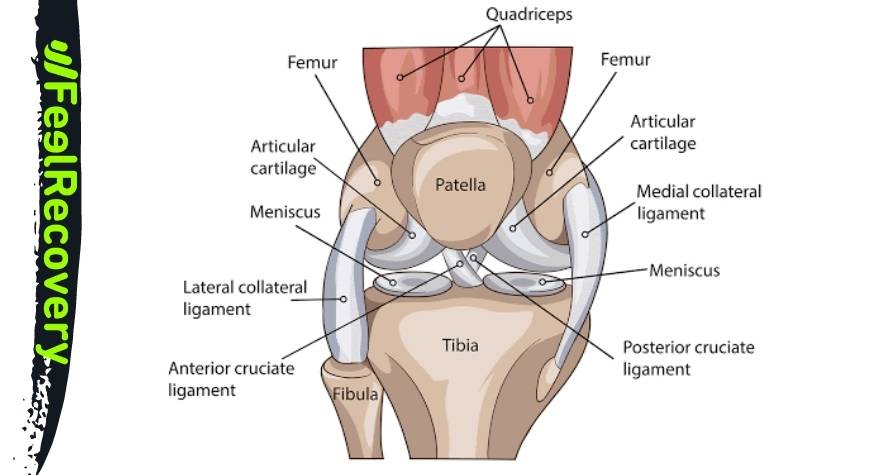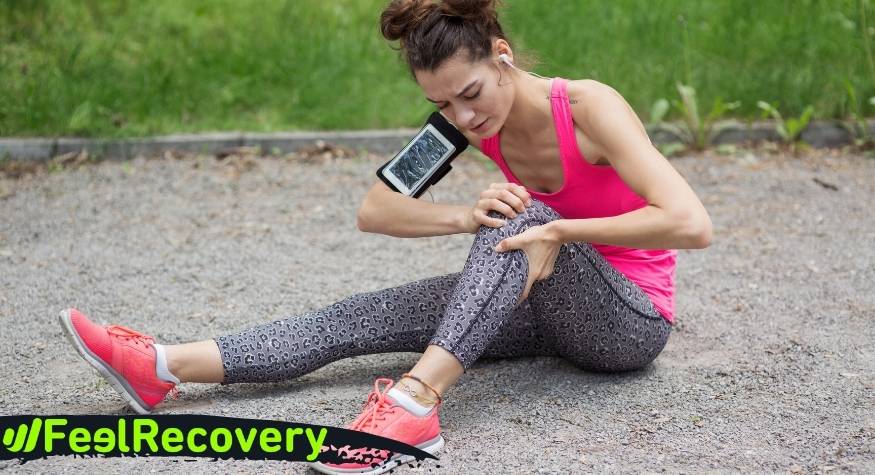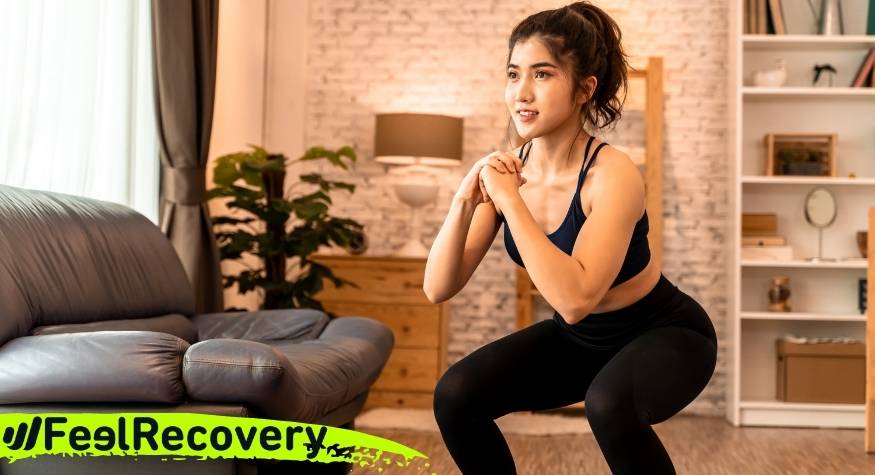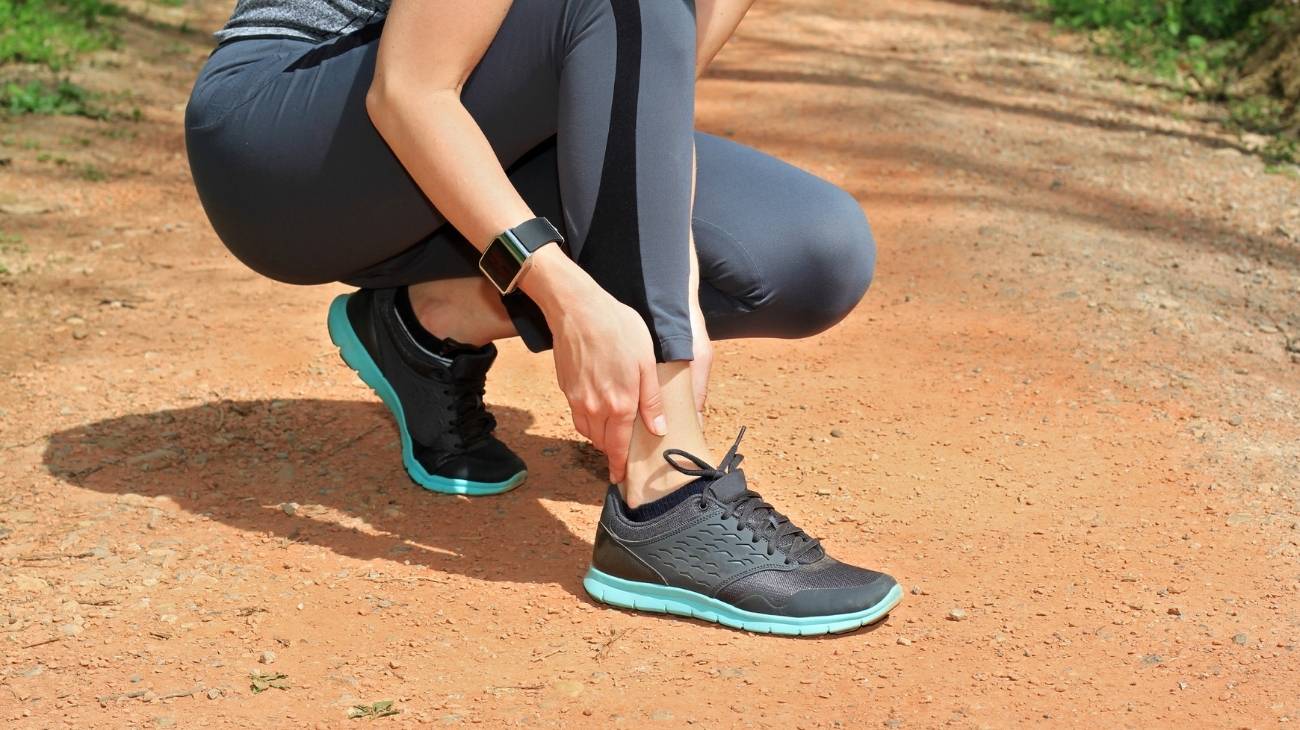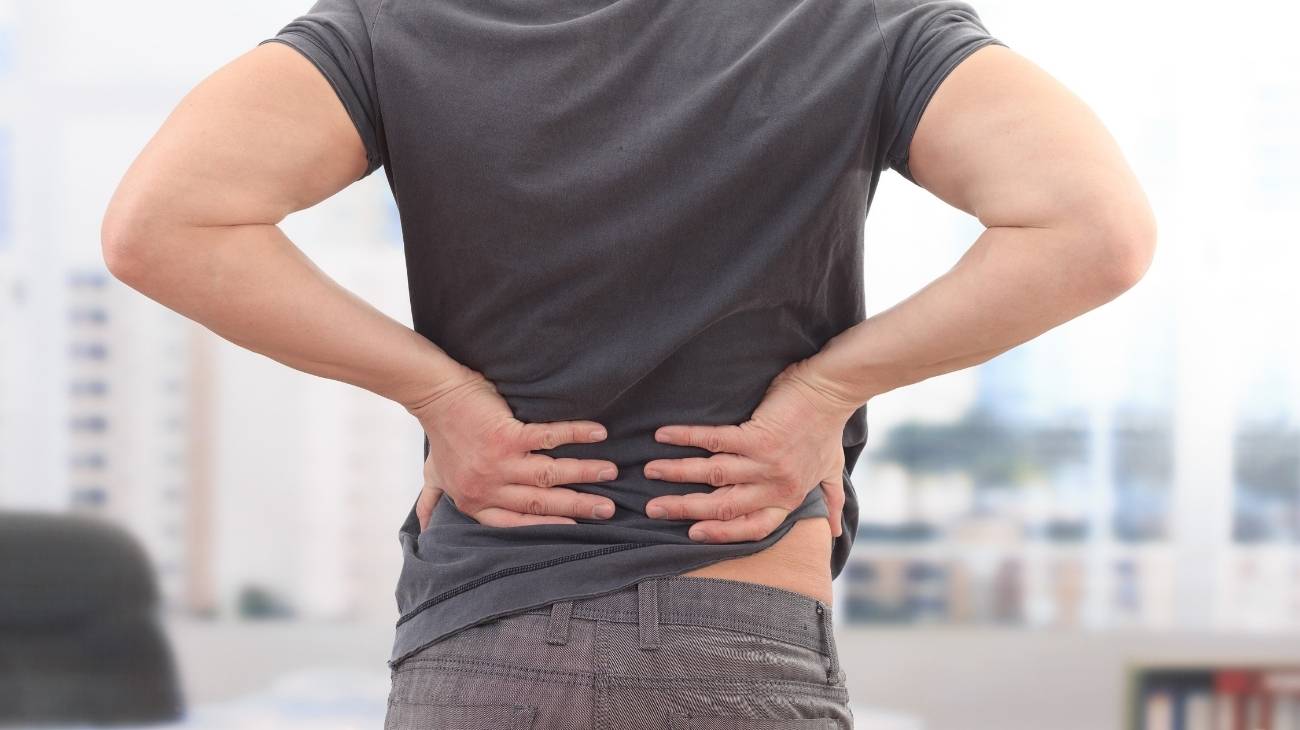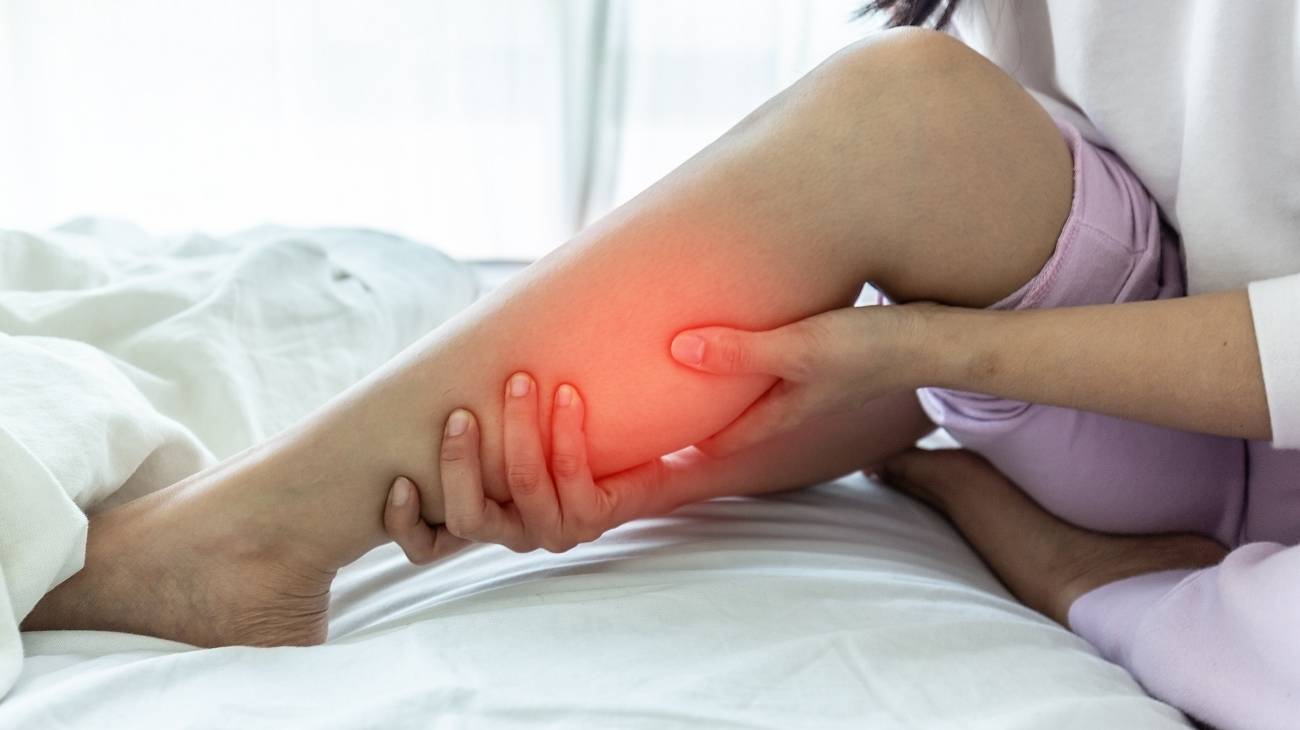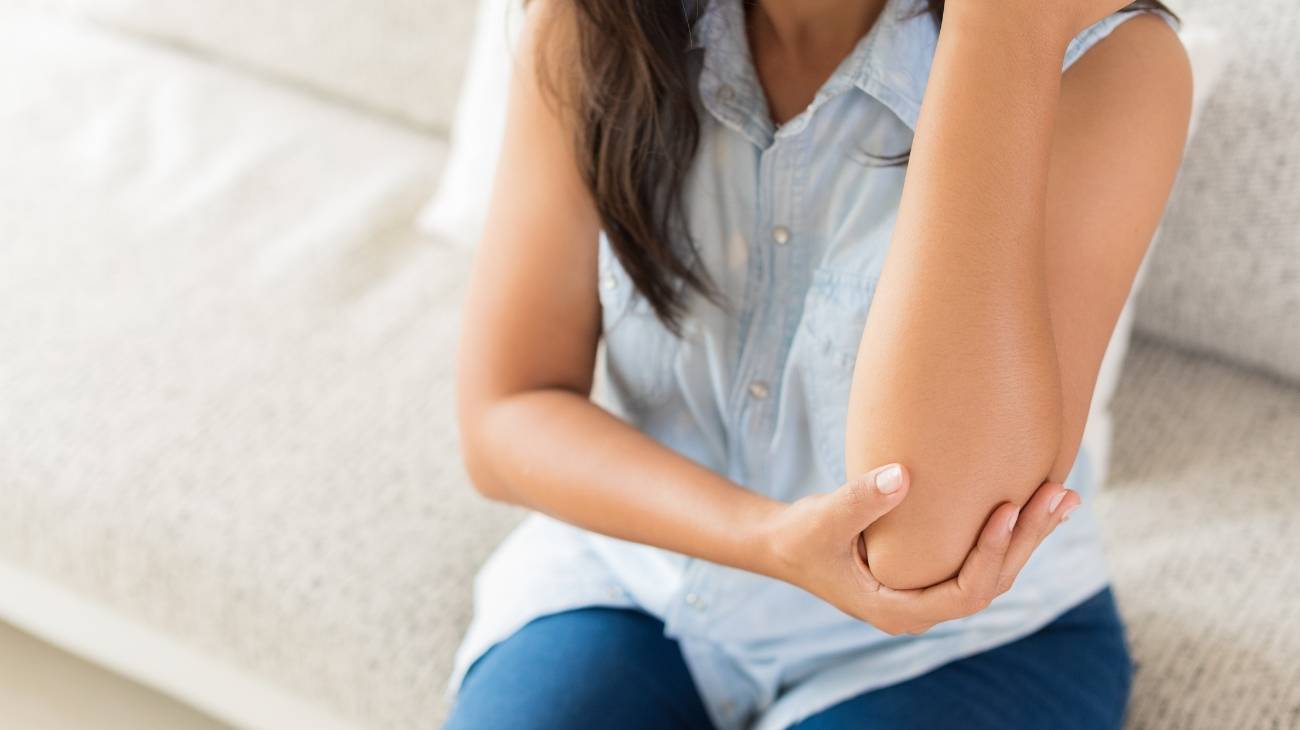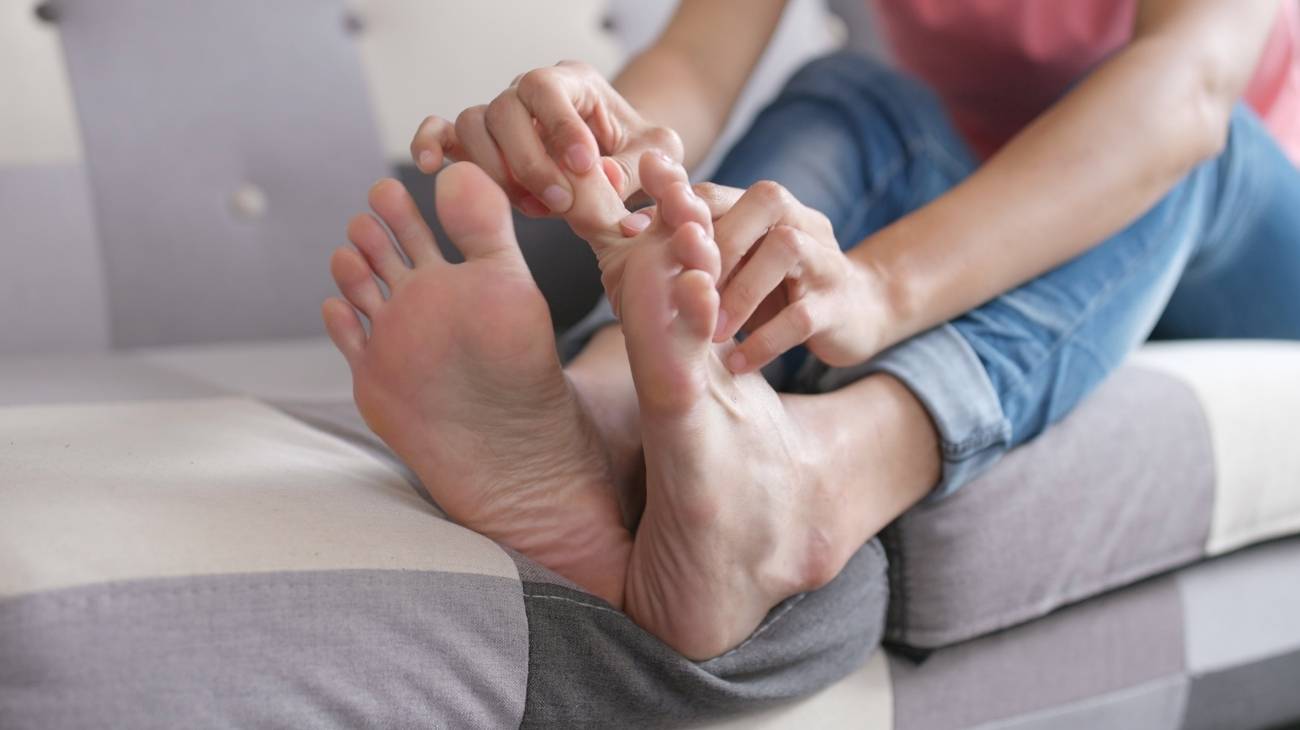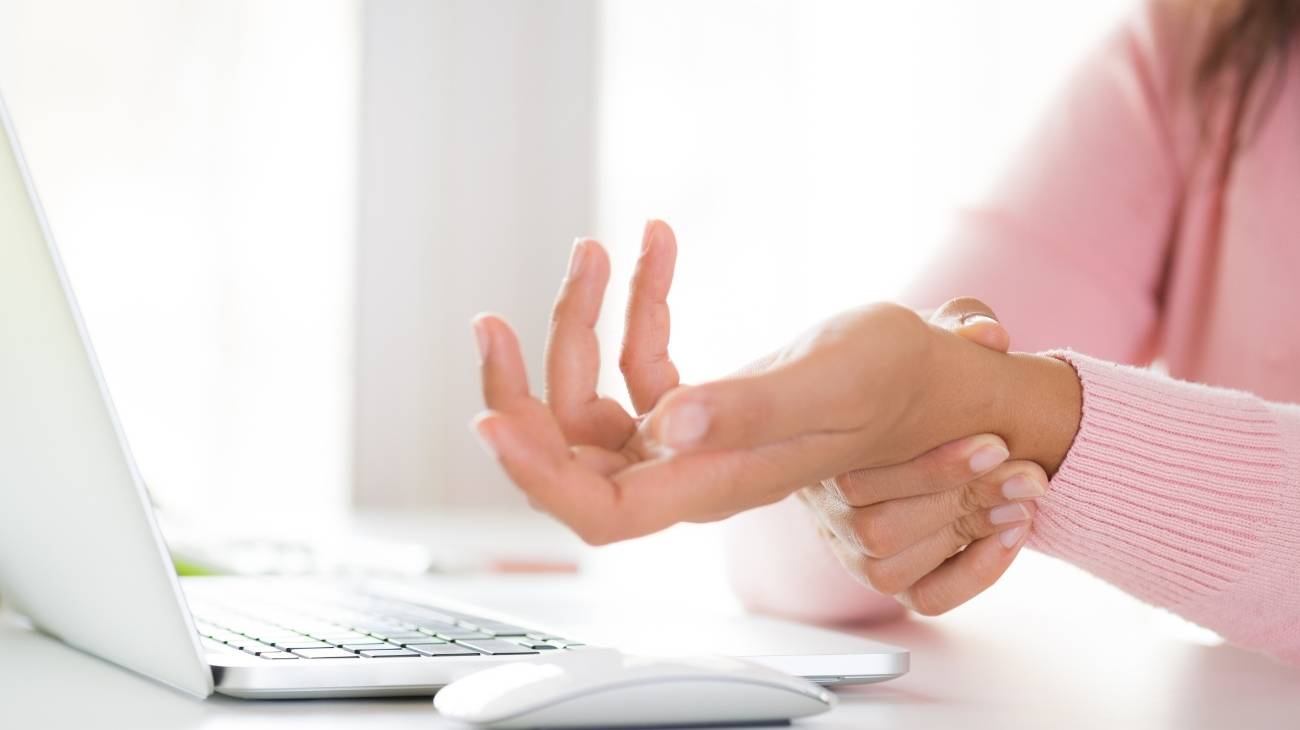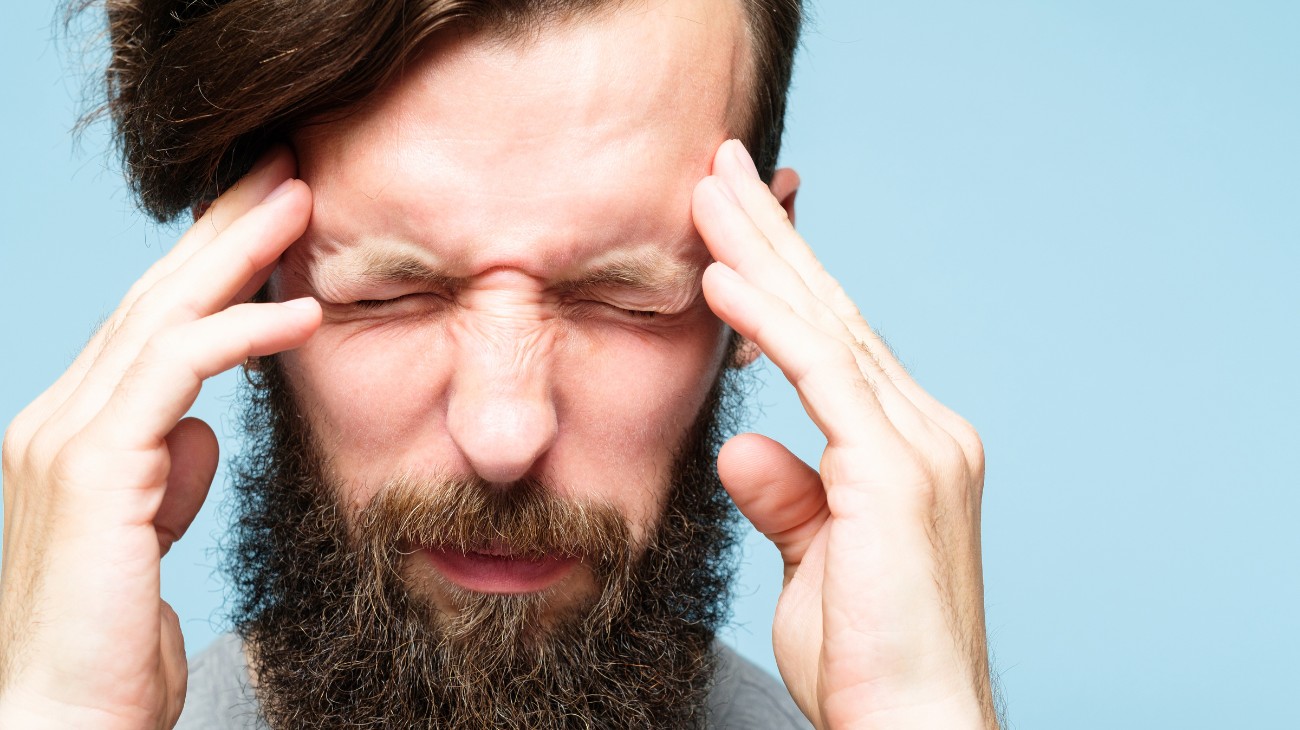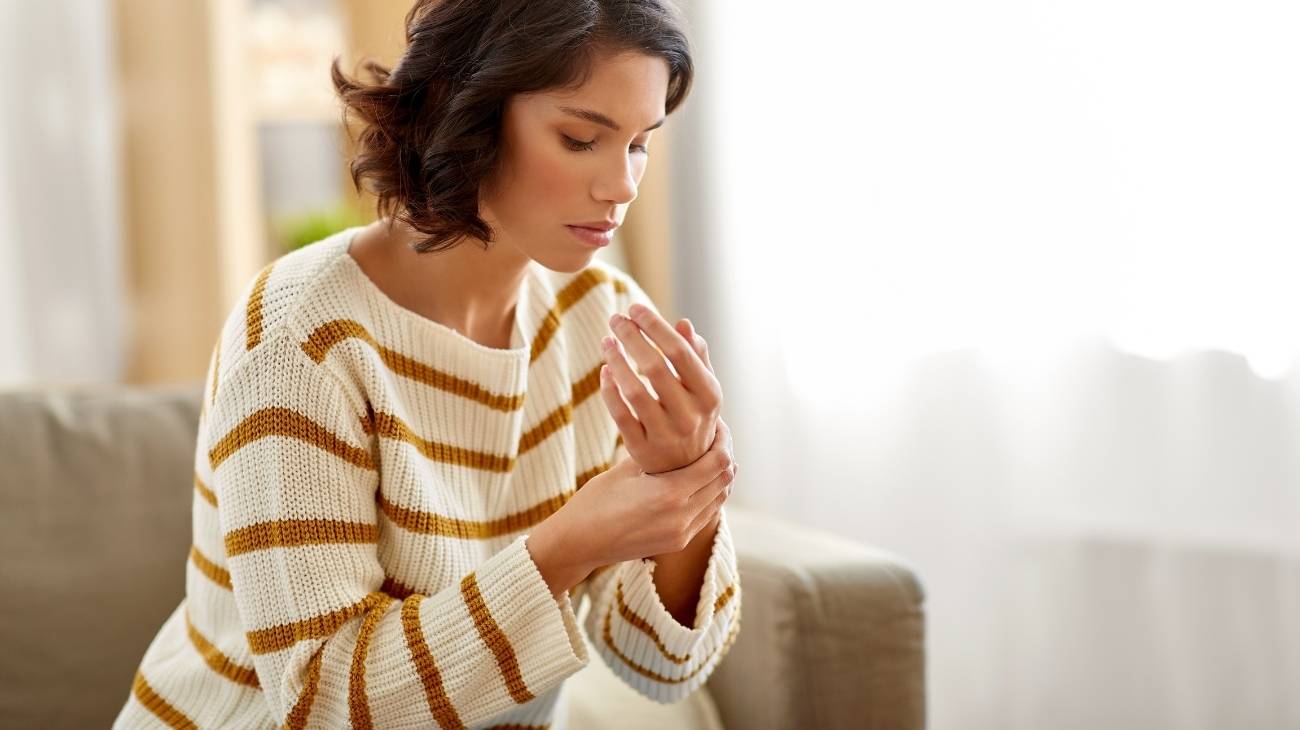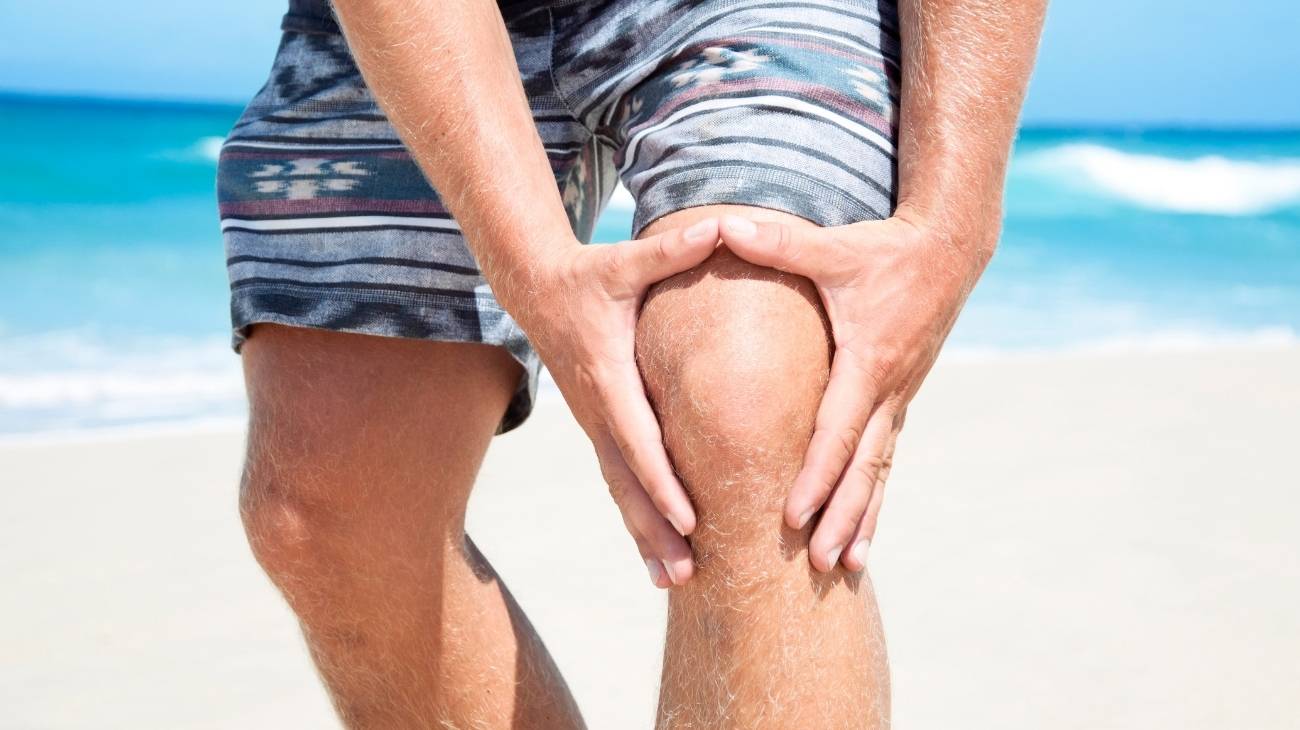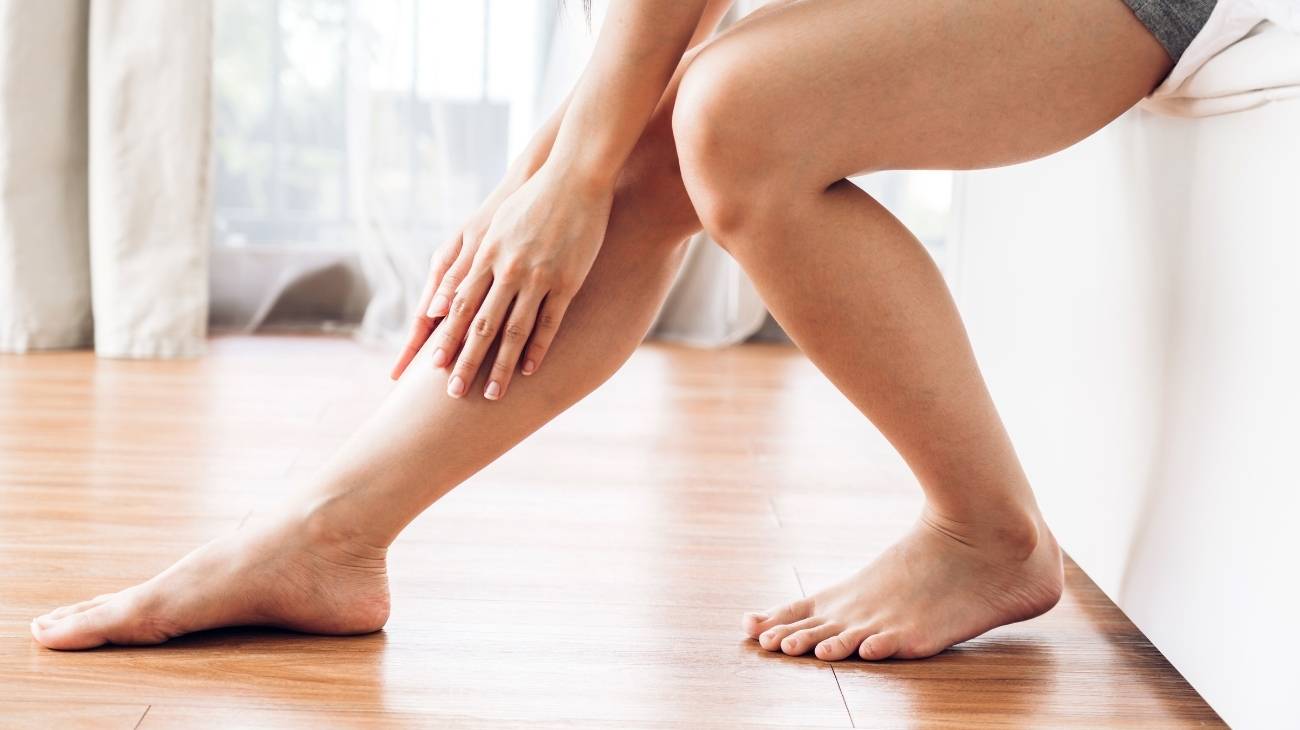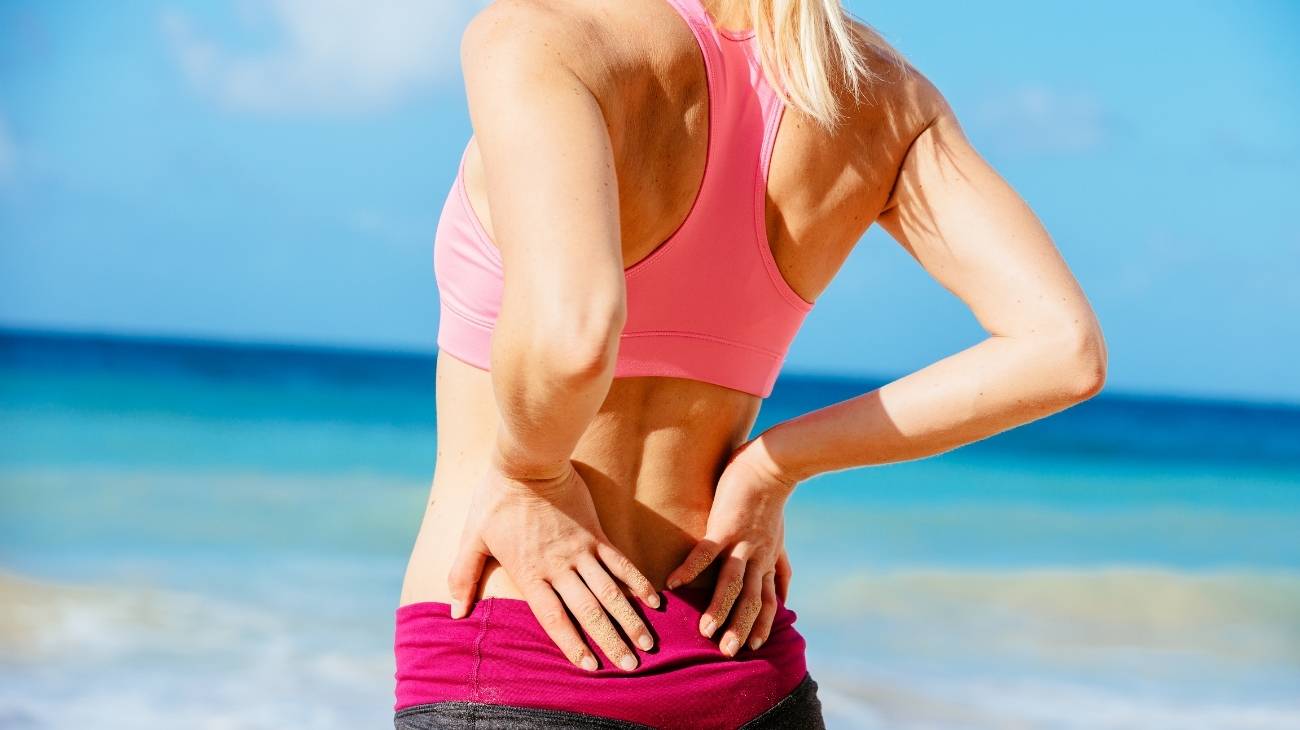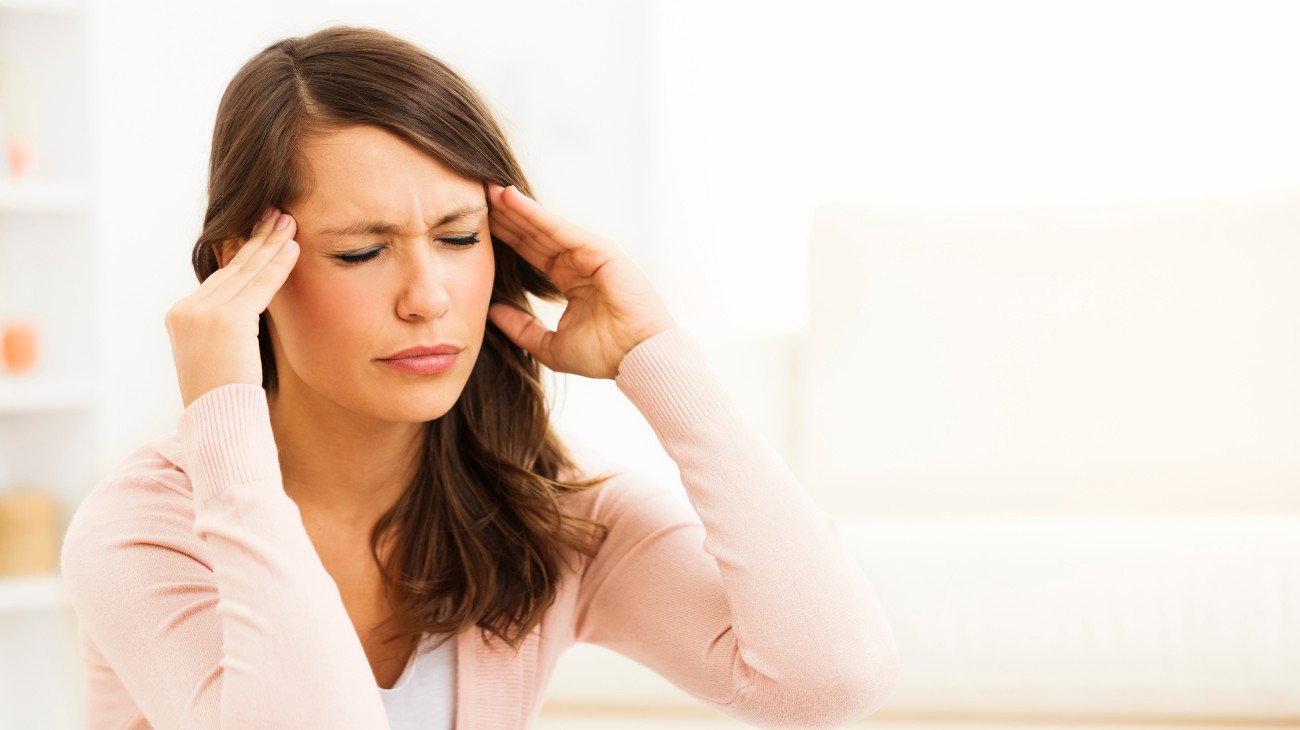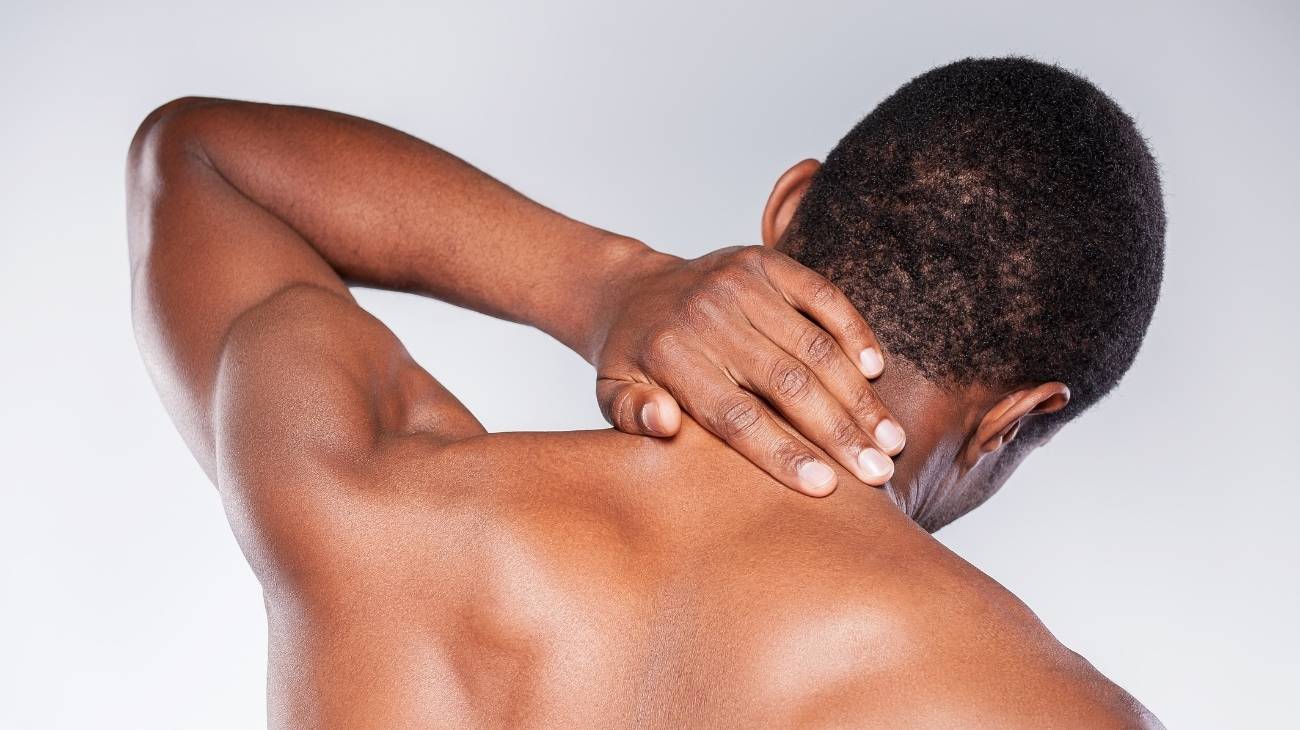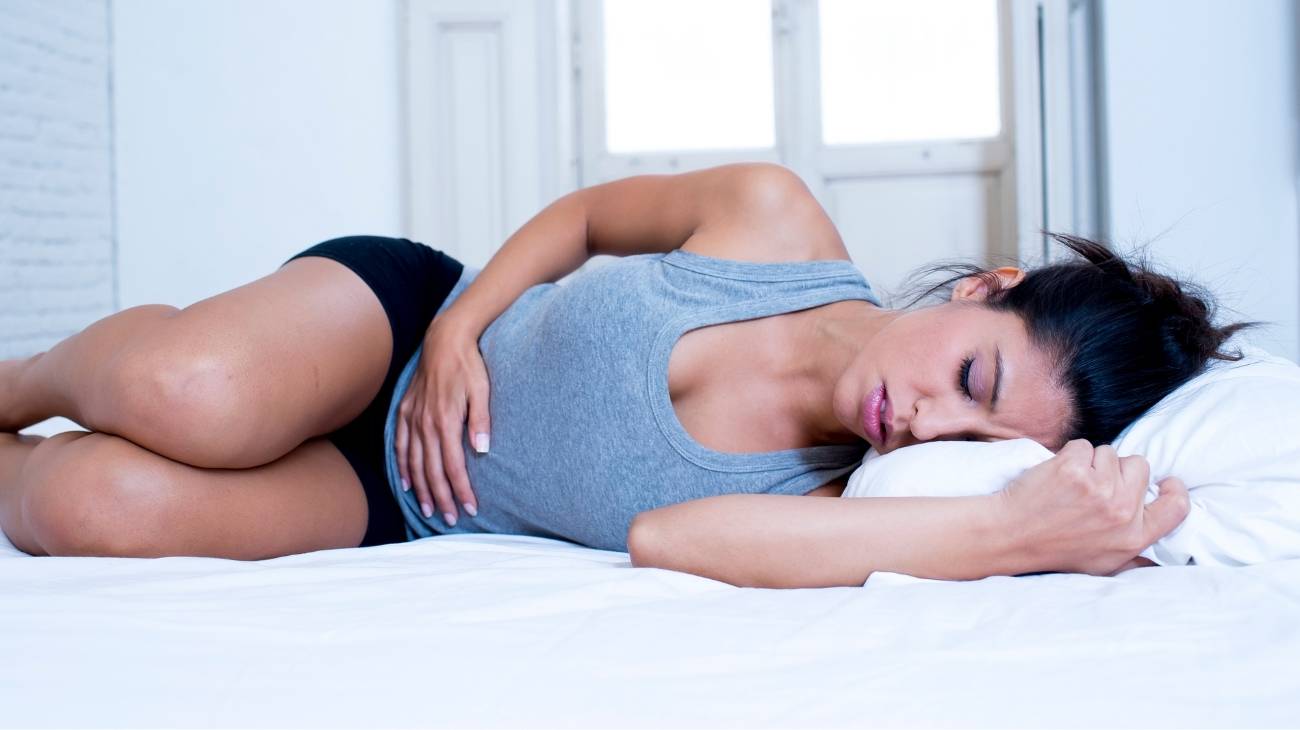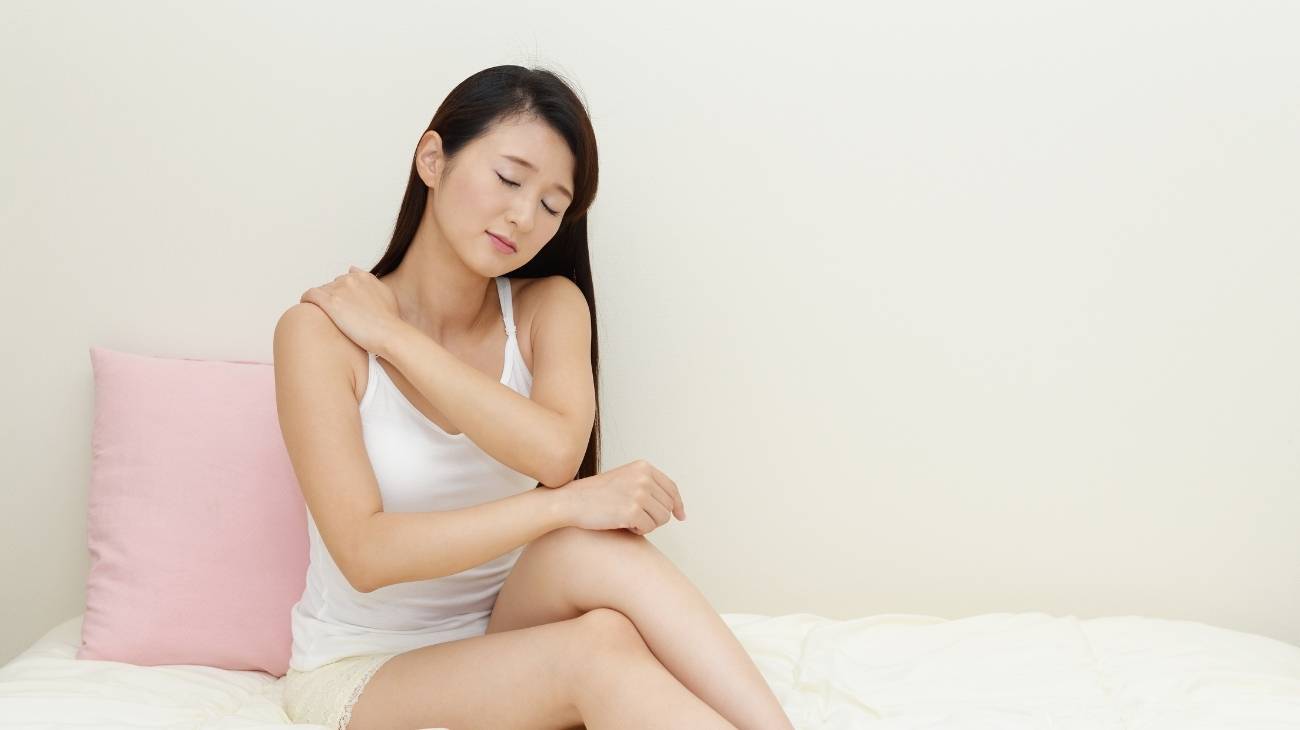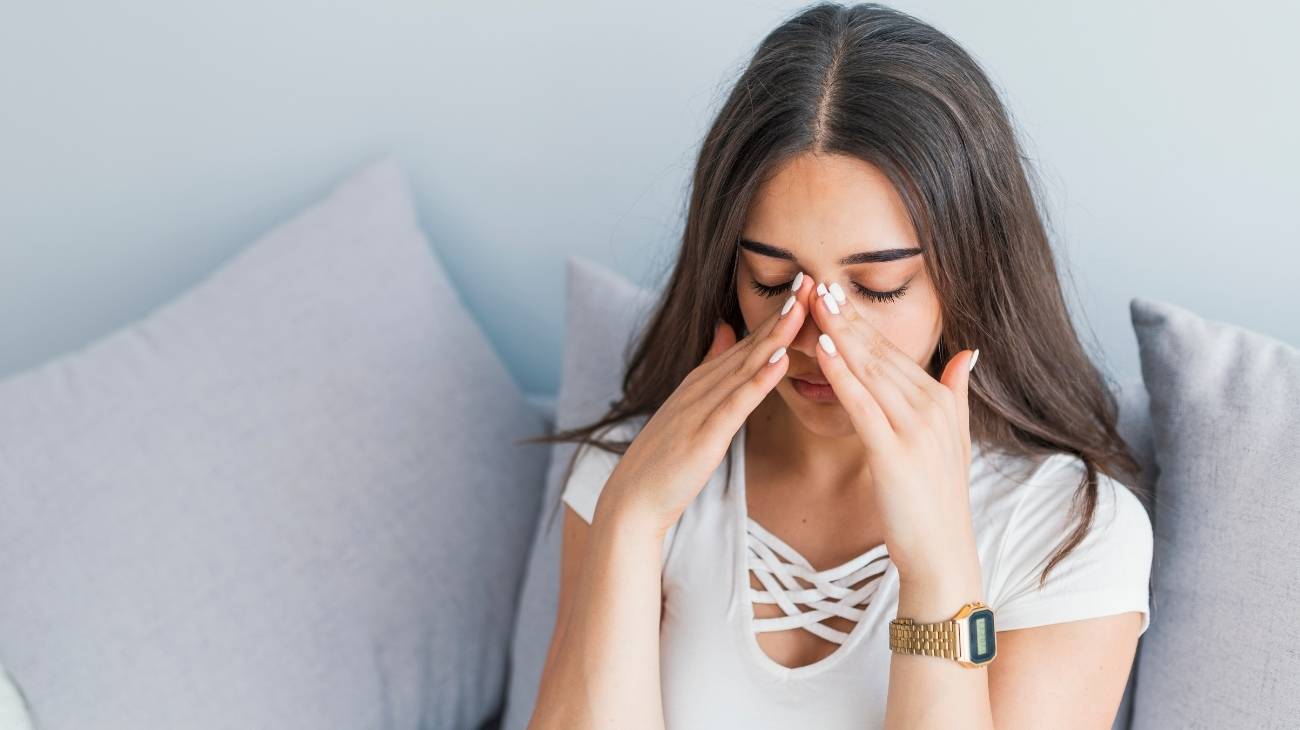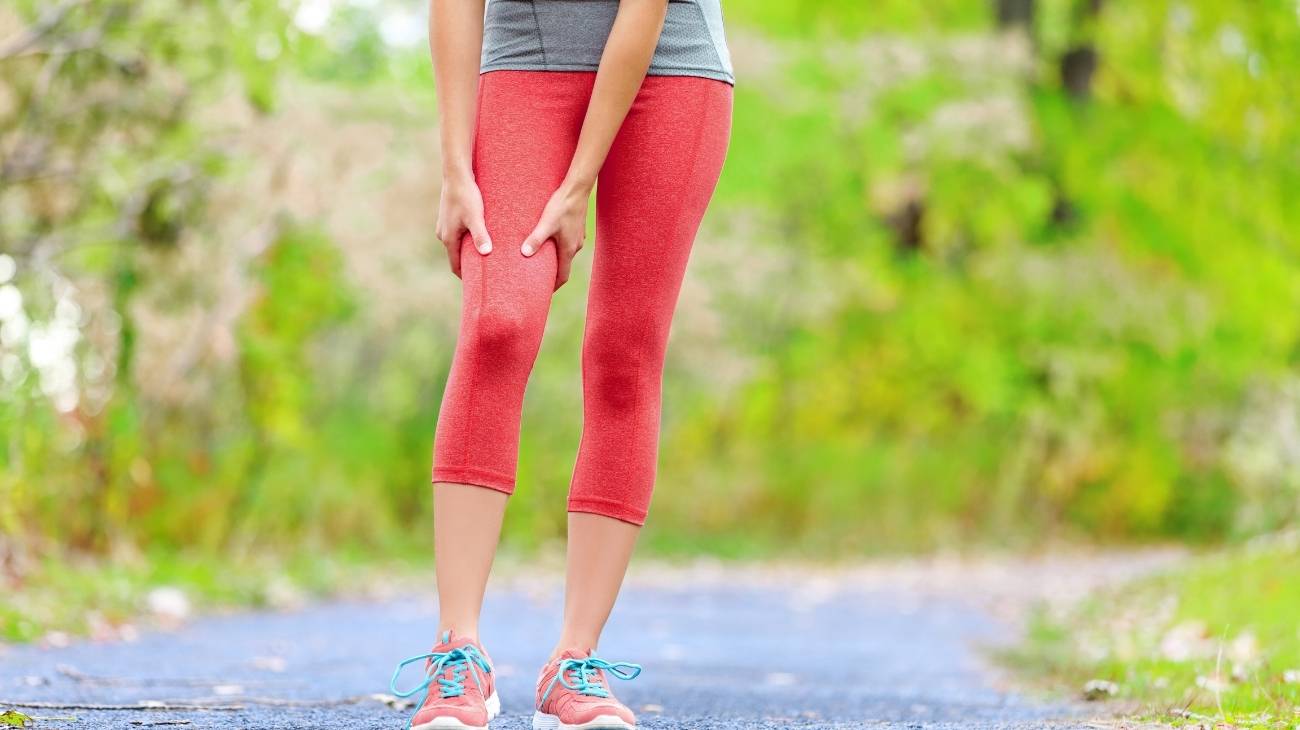- What is knee pain and how to identify it?
- Best products for knee pain relief
- What causes joint pain in the knee and what are the causes?
- What kind of diseases can cause pain in the knee joint?
- What are the symptoms and types of pain that make us think we have a knee injury?
- How can we relieve knee pain through complementary and non-invasive therapies?
- How to apply the RICE therapy step by step to reduce knee pain?
- How to prevent future joint pain in the knee?
- Why should we avoid pills and injections to relieve knee joint pain?
Reducing knee pain is, for most people, the difference between having a good day and not having a good day. Because this is a large, complex and highly functional joint, which means we need to keep it in good condition to enjoy a good quality of life.
Does your knee joint hurt? This post will tell you what causes knee pain, what is good and what is not to reduce this damage and how you should treat and prevent it so that in the medium and long term it is not a problem for you.
What is knee pain and how to identify it?
Knee pain is a condition that involves a rather unpleasant sensation in the joint area of the leg. It is the largest joint in our body and also very complex. It is easy to know when a knee hurts but it is much more complicated to know which specific part hurts, making a correct diagnosis not always straightforward.
Usually this sensation is dry, coarse, but we should not let ourselves be carried away by this, because there are also really sharp knee pains, especially those caused by trauma, fractures and infections. For this reason, it is best to get to know what types of illnesses and problems cause it and what symptoms accompany it in each case.
Best products for knee pain relief
Bestseller
-
Microwave Wheat Bag for Back Pain Relief (Extra Large) (Hearts)
£24,95 -
Microwave Wheat Bag for Back Pain Relief (Extra Large) (Oxford)
£24,95 -
Microwave Wheat Bag for Back Pain Relief (Extra Large) (Sport)
£24,95 -
Microwaveable Wheat Bag for Pain Relief (Hearts)
£20,95 -
Microwaveable Wheat Bag for Pain Relief (Oxford)
£20,95 -
Microwaveable Wheat Bag for Pain Relief (Sport)
£20,95 -
Wheat Bag for Microwave Classic Bottle Shaped (Hearts)
£20,95 -
Wheat Bag for Microwave Classic Bottle Shaped (Oxford)
£20,95 -
Wheat Bag for Microwave Classic Bottle Shaped (Sport)
£20,95
What causes joint pain in the knee and what are the causes?
The knee can hurt for many reasons because, as we have seen, it is quite complex, containing all kinds of soft tissues such as ligaments, cartilage and muscles and other elements such as bones. For this reason, many of the situations we experience every day can cause or aggravate damage.
Let's take a look at the most common causes of knee pain:
Ligamentous wear and tear
Ligamentous wear and tear is often the most common long-term knee problem and, unfortunately, there is no cure. This is caused by continuous activity over long periods of time or by overstraining the joint. It is very important to take care of the ligaments, as they are flexible and make the natural movement of the knee possible.
Trauma, blows and falls
It is obvious that any trauma, whether it is caused by something falling on the leg, a fall or a blow, will cause pain that can range from mild to severe. The type of pain will depend on the intensity of these traumas, the area affected and the characteristics of our own body. Remember that the knee is really a complex joint, like the ankle, so that a blow affects practically all its parts.
For these cases, knowing that the first aid application of the RICE therapy and perhaps some physiotherapy sessions should be enough to reduce the pain. More serious cases do require other curative methods such as immobilisation, sessions with other experts or even, if there are breaks or displacements, surgery in the operating theatre.
Running and cycling
For those who practise cycling, a correct position on the bike is very important to avoid certain discomforts, especially in our joints. If the saddle is too high or too low, we will strain our knees and end up with pain. If you are going to practice this sport on a regular basis, go to a professional who can advise you on the correct posture on the bike.
For runners, especially those who are just starting out, having toned muscles that can withstand the impacts during the race will reduce the pressure and work that our knees have to bear when running. Proper footwear, stretching sessions, strengthening of the leg muscles and physiotherapy treatments will be ideal methods to avoid long-term problems.
When doing deep squats
The deep squat is an intense and quite complete exercise, but it requires considerable technique to perform correctly. Poorly executed or overdone, it can strain the anterior cruciate ligament of the knee, wearing it out or tearing it.
If you have felt discomfort when doing knee flexions with weight, stop doing them until you feel better after a couple of days of rest and ice, when you start doing squats again, make sure you do it in the correct way, although it is recommended that the knee does not go above the tip of the toes, for experienced athletes this is not a problem, you will be the one who must assess whether this is harmful or not.
At rest or when resting
In these cases, it is common for us to feel pain simply because we are "cold", that is, because we have not articulated the leg for some time. Of course, there must be a previous problem, either an injury or an illness that means that one of the many parts of the knee is not able to function even in basic situations.
Sedentary lifestyles or being overweight, as we shall see later, are triggers for joint discomfort even when we are standing or sitting. When we do not exercise our body on a regular basis, the joints deteriorate, losing flexibility and functionality in their components, and if we add to this overweight, all the symptoms are aggravated.
Due to being overweight or during pregnancy
For those who are overweight or obese, in addition to all the complications associated with this condition, if their knees begin to fail, they are more unable to perform physical exercise, even if it is only walking, and this will make their condition worse.
Pregnant women should watch their weight as much as possible. Although it is normal for some joints, such as the knees, to be affected by the body changes, they should not be overly concerned if they return to their pre-pregnancy weight.
Pain when going up or down stairs
This is usually due to an irritated tendon or two parts that are misaligned and moving abnormally over each other. Examples of this would be a swollen muscle ending over a ligament or a tear that puts too much pressure on the upper tissue that protects it. Heavy stair climbing and poor posture, including being overweight, will also make climbing or descending stairs painful.
If you feel pain in your knee when going up or down stairs, the cartilage may be worn or damaged. Remember that the cartilage is responsible for cushioning the play of the joint and ensures that the bones do not collide with each other, if this part of the knee is injured, pain occurs.
Pain when stretching
This is a rather rare case, so it is also easy to diagnose. It is usually due to runner's knee syndrome. Other cases, infrequent but very important to consider if you have suffered an impact, is that some of the parts that make up the knee have become dislocated or even displaced, so that when stretching the leg we are subjecting the tissues to friction or that they are simply stretching more than this "foreign body" allows them to. In this case, you are most likely to suffer from a dislocated kneecap or patella.
Referred and radiating pain
The knee is one of the areas where referred pain can be felt without much difficulty. It can be caused by problems in the hips or thighs, or even by an uneven footing due to improper footwear, either because of pain in the feet or ankles or because of a special condition.
A bad posture is almost always the reason why, in one way or another, we end up using the knee in an inadequate way. It also happens that, because it is the junction point of many tissues, the pain radiates through them along their entire length until it ends up in the joint.
Stress and emotional causes
Although there are not many, there are some emotions that are related to knee pain. Fears of losing a job, being inflexible to change, not being able to tolerate hierarchies and, in general, changes related to our social position, can radiate pain in this area. Of course, stress is both a cause and an aggravator of the damage that can be suffered. It most directly influences shooting pains and muscle cramps.
Exercise and intense strain
Any strain beyond the knee's capacity can lead to overloading of the knee. The area is sore, capacity and even mobility is lost. The good news is that a good warm-up and the right pace of exercise can easily solve this symptom.
Knowing our body and knowing what it is capable of at any given moment will ensure that we do not overexert ourselves and thus avoid future injuries. In addition, doing sport progressively, warming up before each workout, stretching and eating and drinking properly will prepare us physically to reduce the possible risks of suffering from any knee pain.
What kind of diseases can cause pain in the knee joint?
As in the rest of the body, the knee can develop all kinds of diseases that can damage the knee joint, whether at the bone level, soft tissue level or even through the blood or nervous system. Let's see which are the most common.
Arthrosis
The knee cartilage wears out with excessive use, causing the parts it protects to start rubbing against each other when articulating the knee. This causes great pain, which is worse when we try to make a movement after sitting or lying down for a long time.
Osteoarthritis cannot be cured but it can be prevented, so when the pain occurs all you can do is try to soothe it with rest (with the knee in flexion) by moving the joint from time to time and putting heat on it, as in any case of chronic pain.
Sprains
The medial ligament is overstretched, resulting in a partial or even complete tear of the medial ligament or the collateral ligaments, which are secondary stabilisers. Depending on the tear, this is how the sprain is classified and, of course, so are the consequences. In terms of severity, the symptoms that appear are: minor bleeding, unstable effusion, moderate functional impotence, localised pain, increased instability and reduced mobility.
For mild sprains, the conservative approach of the PRICE method should be sufficient to treat the injury. If symptoms persist or if the sprain is moderate, physiotherapy sessions will be really important, as a poorly healed area will cause continuous and increasingly severe problems. Immobilisation and surgery may be unavoidable in some cases, for example when the lateral ligaments are damaged.
Fractures
Fractures, especially complete fractures, are a major cause of pain in any part of the body. In the knee, the patella, tibia, fibula or femur may be broken. In addition to considerable pain throughout the joint, the joint will become very tender, swollen, the natural range of motion will be lost, walking will become much more difficult (or even impossible) and bruising or deformity may occur depending on the degree of fracture.
You will have to perform the PRICE therapy of first aid, but it will not be enough. Perfect alignment of the damaged bone must be achieved, which usually involves surgery or, at the very least, total immobilisation in a plaster cast or splint. The progression is very slow. A meniscus fracture is usually more untimely than a break of any other bone in the knee. Its rupture causes pain when you turn your knee, and the knee will swell and become stiff, making it very difficult to straighten your leg.
Dislocations
Kneecap dislocations occur when the kneecap moves out of place or slips out of place. The bone usually moves outwards, but there are also cases in which it moves inwards, colliding with the complex system of the joint and potentially damaging the many parts that make up the joint.
Symptoms include enormous tenderness, as well as pain and swelling, a more or less obvious feeling of a loose kneecap (you can move it yourself), deformity occurs and, after bending the knee, the leg is not allowed to straighten out again. It can become a recurrent problem in some patients and the symptoms become less severe each time it happens.
Patellar bursitis
This joint, like this, has a bursa of synovial fluid designed to cushion the knee. For various reasons, whether due to trauma, gout or rheumatoid diseases, the bursae begin to accumulate more fluid than they should because they become inflamed. This can be aggravated by pressure or by moving the knee, which can become swollen and red depending on the severity of the problem.
Use resources to help relieve the pressure on the area, see a physiotherapist to recommend specific exercises and, when you are ready, return to sport gradually, choosing activities that strengthen the muscles around the knee.
Gout
A very specific disease caused by the accumulation of uric acid crystals. There is also pseudogout, which, in this case, accumulates calcium crystals inside the synovial fluid sac. The knee becomes rapidly inflamed for no apparent reason, accompanied by severe pain, high sensitivity, redness and a rise in temperature commensurate with the inflammation, and even fever.
It is a pathology that subsides on its own, but with a high probability of recurrence for the rest of our lives. Each attack will be more intense, longer lasting and with worse consequences. Among the few solutions that can be found are prevention, lowering the level of uric acid in the blood, eating a healthy diet, and, of course, treating the symptoms as soon as they appear, resting and using cold therapy on the area if the symptomatological picture has been sudden and includes acute pain and inflammation.
Patellar Tendonitis or Jumper's Knee
The tendons become irritated and inflamed from short-term overuse or repetitive strain, gradually tearing. The tendons become tender and cause us to feel pain, mainly at the bottom of the kneecap, towards the shin.
This process worsens until it interferes with day-to-day activities and, if we do not improve the tendon situation, the process will lead to tendinopathy (tendon degeneration) . It requires physical therapy to help strengthen the muscles surrounding the knee properly.
Iliotibial band syndrome
The iliotibial band, which runs from the hip to the knee, becomes tight and rubs against the femur. This is a problem that sportsmen and women often suffer from, but it is not exclusive to them, so you should not rule it out. It is known as iliotibial band syndrome or "runner's knee".
It causes severe pain on the outer side of the knee due to continuous bending and stretching (more intense when walking slowly and downhill). This leads to inflammation. The symptoms are progressive and persist during activity, disappearing when you rest. Apply cold to deflate the area when it hurts a lot and return to your activities progressively. A visit to a physiotherapist is recommended.
Osteochondritis dissecans
The blood supply is not sufficient to nourish the bone and a small part of the bone is defragmented, leaving a small piece loose. This may never be a problem, but on many occasions, this bone fragment does irritate tissues or dig into them, causing pain and making them unable to perform their function properly, making some movements impossible.
If symptoms occur, it is best to remove the foreign body, as it can cause more serious damage. An incision can be made , although if it is a small fragment, it may be possible to solve the problem with waves or laser.
Baker's cyst
A baker's cyst is a small ball of synovial fluid just behind the knee. Under pressure, the fluid can move around and press against the back of the knee, or it can come straight out of the bursa. It is almost always caused by arthritis, injured cartilage, torn meniscus cartilage or problems that cause inflammation of the knee or the membrane covering the knee.
Sometimes you may not notice it until it is well developed. There may be swelling, with or without pain, or the cyst may feel like a water balloon. If it ruptures, there will be much more pain and swelling and also a haematoma. Treatment involves correcting the cause of the cyst or directly removing it, although it is very common for it to reappear if the cause is not treated.
What are the symptoms and types of pain that make us think we have a knee injury?
Relieving knee pain is not always easy as there are many symptoms that accompany and aggravate it. In any case, it is good to be aware of this range of symptoms in order to be able to make an accurate diagnosis and provide the most appropriate care.
Most common types of symptoms
- Pain: We have found that it varies greatly depending on the area affected and the type of circumstance that causes it. In general, the pain is dry and incapacitating, but there are also very intense acute phases in which many other symptoms can be felt.
- Swelling: This is caused by blows or falls, or by pressure of any of the parts, especially the patella against the patellar ligament or the quadriceps tendon.
- Stiffness: This is usually bone stiffness, due to joint failure or a severe injury directly to the bone. It also occurs from hours of inactivity, lack of synovial fluid or ligament malfunction.
- Locking: The ligaments shorten too much and we are not able to do the flexion. It is also possible for this to occur in an unnatural posture with any type of tissue, especially if we make an unexpected movement.
- Redness: A blow or inflammation will be the cause. It is not considered a serious symptom as long as it does not get worse as the days go by.
- High temperature: Also caused by impact and inflammation, the knee becomes hotter because a lot of blood is circulating and the immune system goes to work to try to get everything back to normal after the injury.
- Reduced movement: Detached or foreign bodies reduce movement, but also overlying tissue or pain itself prevents us from carrying out the function of the knee properly.
- Weakness: A complicated area whose involvement often results in weakness of both the area and the leg, extending upwards and downwards.
- Joint instability: Situations such as the presence of foreign bodies, cysts, dislocations, etc., will cause us to lose control of the various functions of the knee.
- Clicking: In the knee it is very common, for various reasons, to feel sounds such as cracking, popping or popping. Each one is related to a different problem, so it can be very useful to know them in order to know why our knee hurts.
Types of symptoms depending on the area of the knee
- Anterior pain: Apart from the typical knocks, which always go to the kneecap as it is the largest and most prominent bone, the pain can be caused by fatigue after being active for a long time. Fatigue, even unjustified, will accompany you and your legs may even go numb. It doesn't matter if it stops with rest, but if it doesn't, you may need to consult a doctor, as you may be suffering from patellar pressure that makes the pain persistent.
- Back pain: This may be due to stretching much more than your parts can withstand and appears along with rapid exhaustion and tenderness to the touch. But we've also seen that it can be a ligamentous issue or even have a cyst, which squeezes the surrounding area and can lead to synovial fluid leakage (and, with it, infections and lack of protection and cushioning in the area). Pain, as you imagine, can differ greatly depending on the circumstance.
- Lateral pain:
- Internal lateral: In this case, as in the following, you may simply be placing your feet incorrectly (either when pedalling or because you suffer from cavus feet, etc.). It is not accompanied by other symptoms.
- External lateral: In addition to what we have just said, in the external area we can be affected by a problem such as iliotibial syndrome, which irritates the band and produces inflammation and the pain is considerable and increasingly intense if we do not remedy it.
- General pain: Being a large joint, it is not usual for it to hurt entirely but, unfortunately, there are cases where it does occur. These are usually due to bone degeneration, problems in the circulatory system, degradation of the parts (with the passage of many years doing bad activities). It is not acute and ends up becoming chronic as well as producing a reduction in joint amplitude.
How can we relieve knee pain through complementary and non-invasive therapies?
To reduce the damage and symptoms associated with a knee injury, it is often not necessary to take medication. The best thing to do, knowing the problem, is to choose a therapy (or several) that treats the symptoms and their causes.
Cryotherapy
If the pain you are experiencing is sudden, the best thing to do is to apply cold. It is a staple for bruises and, in general, for injuries that occur unexpectedly and when there is swelling. Putting cold on the knee makes the area numb, gently anaesthetising it, which makes the pain less noticeable. In addition, we reduce blood pressure and therefore the swelling is reduced. Use specific products such as cold gel packs to treat injuries, respecting sessions of a maximum of 20-25 minutes every 4 to 6 hours, you can apply cold at least 3 or 4 times a day for the first 24-72 hours after suffering the injury.
Thermotherapy
Applying heat to the knee will help relieve non-acute pain. These are those that have been with us for some time or some types of pain that are caused by illness or have become chronic. What is important for heat therapy is that the pain is not acute and that there is no inflammation, otherwise heat therapy is a bad idea.
Heat and cold therapy
Temperature contrast is very good for relieving knee pain in some cases, but not in general. You should use it by applying heat and cold alternately . This therapy is usually used in three very specific cases: when it is determined that your tissues need to be nourished more than usual, if the pain is very focused, or if you have pain due to rheumatic diseases.
Acupressure therapy
Due to the complexity of the knee joint, it is recommended not to work on it directly. The ideal solution is acupressure, in which, by touching other points of the body, we can relieve the pain in the knee.
Some points to stimulate are:
- LV3, D (Command activity)
- E (Valley joint)
- F (Gushing spring)
- G (Shady side of the mountain).
Compression therapy
It will be used very often in serious injuries, seeking to maintain the structure of the joint as a whole, in the case of fractures, so that the bone welds properly, and, in general, to be able to continue with our daily lives if we feel a lot of pain and instability and we need support to walk and carry out our activities.
We must know the level of compression necessary according to the circumstances and vary it with the resources available. First with splints, then with bands and finally with compressive knee braces that offer support, improving blood flow, which leads to a quick recovery.
Massage therapy
Massage is certainly not particularly suitable for the relief of knee pain. It does apply to treat some specific conditions, and also in case the pain spreads to other areas and comes from the thigh or calf. In this case, it is advisable to massage these muscles, but if the knee is injured, it should not be massaged except in specific cases such as goosefoot tendonitis and only when determined by a medical expert.
Other effective alternative therapies
There are a number of other practices that are also used, in conjunction with or as an additional option, and are also functional in relieving knee pain.
- Natural remedies using plants: Take infusions of plants and flowers that have analgesic properties (mint, rosemary, valerian, lavender, nettle, etc.). Then choose the rest depending on the symptoms (antiseptic, anti-inflammatory, etc.).
- Acupuncture: A specialist will work on the same points we have seen in acupressure but using needles that will be inserted a few millimetres into your skin.
- Kinesiotherapy: This is undoubtedly one of the most effective alternative therapies for the relief of knee pain and recovery. The different movements will be determined depending on the problem you have, but the most common is a mobilisation with load on the affected tissue to align it and weld it properly.
- Ultrasound: Very suitable for reducing or even reducing inflammation and at the same time helping the affected tissue to heal.
- Microwaves: If the vascularisation of the area needs to be improved, the ideal is to have a microwave session. With this, tissue regeneration will be accelerated.
How to apply the RICE therapy step by step to reduce knee pain?
One of the best known therapies in the physiotherapeutic and sports world is the RICE protocol, as it is mainly used to treat injuries, pain and inflammation in general very effectively and quickly. Later, the PRICE methodology appeared, the same therapy but with the addition of a first step that basically focuses on the protection of the area and the injured person.
Here we see them:
- Protection: This first step includes everything that comes before treating the injury, pain or inflammation. From placing the affected area in a specific position, to cleaning the area in a certain way.
- Rest: No matter how minor they may be, all injuries require a certain period of rest during which we will never completely stop the activity. Unless the injury is very serious (such as a total fracture), this is not recommended. What we should do is not overexert ourselves, walk with the help of a cane or crutch if necessary and rest for a few hours a day.
- Ice: Cold therapy is a technique that can be used to reduce or even eliminate knee pain. This can be improvised by wrapping ice in a cloth and applying it to the affected area, although it is ideal to have something more specific, such as ice gel packs and other specialised cold therapy products.
- Compression: Pressure on the affected area can also combat pain in an injury, holding bones and other parts in place for proper and faster recovery. Compression therapy has been proven to help speed up recovery from injuries, in this case a compression knee brace is recommended.
- Elevation: Keeping the affected area above the heart will avoid increasing the inflammation, as we will reduce the blood flow reducing the symptoms produced by the injury.
How to prevent future joint pain in the knee?
The best methods for relieving knee pain is undoubtedly prevention. There are many healthy lifestyle habits that will give us certain guarantees of not suffering from illnesses or accidents, thus reducing the risk of injury.
Let's take a look at the most common preventive methods:
- Warming up: The knee is very complex, it needs warming up before any activity, not only sports but any activity that we know can load the area (such as lifting weights, going up and down stairs, etc.), especially when we have no other alternative.
- Physical activity: Sport is really beneficial for good health. Look for low-impact activities after recovering from your knee pain and gradually increase the intensity with which you do them. You can start with walking and swimming. Afterwards, you can choose other sports, always trying to do them correctly, with protection and good posture and movements and taking breaks, without straining your knees. Opt for cross-training, so that you are not always straining your knee.
- Rest: There are many activities in which repetition and knee play are constant. When practising them, we must take into consideration taking short breaks in which we perform different knee movements and rest. In this way, we do not overload the joint. We should also take a break from sitting or static postures, as this only causes our tissues to atrophy. During sleep, choose an orthopaedic cushion and put it between your knees, especially if you have already developed a degenerative disease such as osteoarthritis.
- Post-exercise treatment: If you engage in intense, high-impact activities, get advice on some simple after-sport treatment. A massage or applying cold to the knees may be enough both to improve recovery and to strengthen the tissues.
- Specific exercises: Do leg muscle strengthening exercises to protect your knees, such as strides or squats. Other recommended exercises are those that promote joint stability and improve proprioception. Tai Chi is one of the best techniques for relaxing the joints, releasing hormones and at the same time, giving us a moment of tranquillity to forget about daily stress.
- Postural hygiene: Know the most suitable postures so as not to strain any of the small parts that make up the knee joint. Sit at a 90º angle at the knee with your buttocks parallel to the floor, sleep with your knees in semi-flexion, do not cross your knees while sitting, etc.
- Nutrition: Aim to stay at your healthy weight so as not to load your knees or ankle. In terms of nutrition, more protein and micronutrients, especially calcium, vitamins A, C and D and Omega3 acids, all accompanied by plenty of water. Get plenty of prebiotics and probiotics to prevent joint wear and tear and inflammation.
- Compression clothing: Look for sports shoes capable of absorbing a lot of impact when you go out for sports. Forget any uncomfortable shoes or high heels. Look for thick-soled, flexible, lightweight sports shoes with a good support system. If you have sensitive knees, have suffered a severe injury or there is a possibility of pain or other symptoms and pathologies, you should get used to wearing compressive knee braces to help prevent dislocations or sprains.
- Contrast therapies: You don't need to feel pain to get hot or cold, but doing so also prevents damage. Depending on your previous problems and illnesses and the situation you are in, you may need to get hot or cold. If your knee feels hot or reddened, put on something cool. Do this also after strenuous activity. If it becomes stiff and stiff, it could do with some warmth. As a general rule, if it doesn't hurt, heat is the best option.
Why should we avoid pills and injections to relieve knee joint pain?
As we have already seen, pain relief can be treated perfectly well without the use of drugs, which are more invasive, and in the long run, can be detrimental to our health. Even so, if a doctor prescribes it, it is because it is the most appropriate thing to do, as he or she has taken your particular case into account.
For our part, it is best not to self-medicate whenever it can be avoided, as the use of drugs in all cases produces side effects. The compounds in the pills may act differently in different people, or even at two different times in our own lives.
If you feel that your pain is too severe or chronic, do not hesitate to go to your doctor for a diagnosis. He or she will always help you by giving you the best advice to improve your health and prescribing a specific treatment that in your particular case can help relieve your knee pain.
References
- Blackburn, T. A., & Craig, E. (1980). Knee anatomy: a brief review. Physical therapy, 60(12), 1556-1560. https://academic.oup.com/ptj/article-abstract/60/12/1556/2727156?login=false
- Abulhasan, J. F., & Grey, M. J. (2017). Anatomy and physiology of knee stability. Journal of Functional Morphology and kinesiology, 2(4), 34. https://www.mdpi.com/2411-5142/2/4/34
- Flandry, F., & Hommel, G. (2011). Normal anatomy and biomechanics of the knee. Sports medicine and arthroscopy review, 19(2), 82-92. https://journals.lww.com/sportsmedarthro/Abstract/2011/06000/Normal_Anatomy_and_Biomechanics_of_the_Knee.2.aspx
- Fulkerson, J. P., & Gossling, H. R. (1980). Anatomy of the knee joint lateral retinaculum. Clin Orthop Relat Res, 153, 183-188. https://www.researchgate.net/profile/John-Fulkerson/publication/246367558_Insertion_orientation_of_terminal_vastus_lateralis_obliquus_and_vastus_medialis_obliquus_muscle_fibers_in_human_knees/links/5ce13498a6fdccc9ddbc7cc9/Insertion-orientation-of-terminal-vastus-lateralis-obliquus-and-vastus-medialis-obliquus-muscle-fibers-in-human-knees.pdf
- Roos, E. M. (2005). Joint injury causes knee osteoarthritis in young adults. Current opinion in rheumatology, 17(2), 195-200. https://journals.lww.com/co-rheumatology/Abstract/2005/03000/Joint_injury_causes_knee_osteoarthritis_in_young.16.aspx
- Yusuf, E., Kortekaas, M. C., Watt, I., Huizinga, T. W., & Kloppenburg, M. (2011). Do knee abnormalities visualised on MRI explain knee pain in knee osteoarthritis? A systematic review. Annals of the rheumatic diseases, 70(1), 60-67. https://ard.bmj.com/content/70/1/60.short
- Scranton Jr, P. E. (2001). Management of knee pain and stiffness after total knee arthroplasty. The Journal of arthroplasty, 16(4), 428-435. https://www.sciencedirect.com/science/article/abs/pii/S0883540301728574
- Barrack, R. L., Schrader, T., Bertot, A. J., Wolfe, M. W., & Myers, L. (2001). Component rotation and anterior knee pain after total knee arthroplasty. Clinical Orthopaedics and Related Research®, 392, 46-55. https://journals.lww.com/clinorthop/Fulltext/2001/11000/Component_Rotation_and_Anterior_Knee_Pain_After.6.aspx
- Fulkerson, J. P., & Arendt, E. A. (2000). Anterior knee pain in females. Clinical Orthopaedics and Related Research®, 372, 69-73. https://journals.lww.com/clinorthop/fulltext/2000/03000/anterior_knee_pain_in_females.9.aspx
- Dulay, G. S., Cooper, C., & Dennison, E. M. (2015). Knee pain, knee injury, knee osteoarthritis & work. Best Practice & Research Clinical Rheumatology, 29(3), 454-461. https://www.sciencedirect.com/science/article/abs/pii/S1521694215000455

